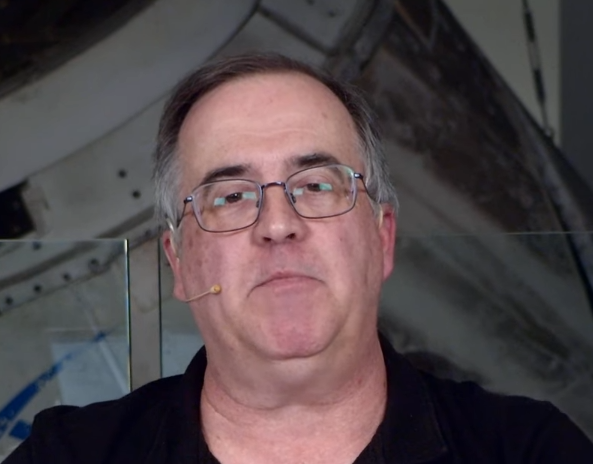I’m asking you. If you’re a follower of his, I suggest you ask him to reupload any deleted videos to a second channel, for the sake of transparency.
This would have been a long time ago, obviously. Reusability is widely accepted these days.
I’m asking you. If you’re a follower of his, I suggest you ask him to reupload any deleted videos to a second channel, for the sake of transparency.
This would have been a long time ago, obviously. Reusability is widely accepted these days.
The missing piece here is that Lueders was sidelined by the administration, and only left NASA after that. I guess we can all agree that this was punishment for her awarding the contract to SpaceX, and the only question is whether she deserved that punishment.
I don’t know. I don’t even know if the claims are true. But having an idea of your maximum price, and only telling any bidders what that is if they are a little bit over, doesn’t seem to me like the kind of thing that would be an uncommon occurrence in government procurement.
My weak guess is that, prior to this year at least, SpaceX has been operating at a vastly lower level than Old Space in terms of dubious business practices, and the baby steps they took in that direction were expertly countered by the masters of the art, and that’s why we’re even talking about this level of detail in the only (?) contract that SpaceX contentiously won, and not the dozens they contentiously lost.


Are you saying that the person who was director of NASA’s HLS program, at the time it granted a contract to SpaceX, had previously worked at SpaceX?
but their goals seem easy in comparison, especially if you consider the tech we have now vs the 60’s
I’d say their goals seem much harder in an absolute sense, but perhaps roughly the same in comparison to the technology level.
They really do seem to be trying to create a Mars colonisation ship. Capable of transporting large amounts of mass for less money than it costs to transport small amounts of mass with existing rockets.
My response to Destin is that Starship is clearly not optimal for another ‘flags and footprints’ mission to the Moon, but is such a paradigm shift that even if doing such a mission as a ‘side project’, it could still very easily be better than all the alternatives. And if, like me, you care more about a permanent presence on the Moon, the case for Starship becomes even stronger.
massive, obvious insider dealing
Is this an accusation pertaining to SpaceX?
Thunderfoot
The guy who had a whole video about how Falcon 9 reusability would never work, and then quietly deleted it when proved badly wrong?
I’d stick with Destin if I were you …
If you’re reading this, Will, there are some typos:
and a then battery that needed replacement
will won’t be ready [Freudian slip, mate? ;) ]
Good point. I wasn’t really thinking what i meant by “the critical path”. I was probably assuming the path to a vehicle & system working (at least qualitatively) as designed - including full reusability.
But now that I think about it, probably the thing that matters most to SpaceX is launching at least one ship during the next Mars transfer window, in order to test their Martian EDL approach. (The critical path to making life multi-planetary?) And for that I guess booster reuse is much(?) more important than ship reuse. Or to put it another way, currently for Starship, Mars EDL is the main goal, and Earth EDL only matters to the extent it helps with that goal.
I should’ve realized this without your question, because after Flight 4 I decided that it was now likely they would be ready by early 2027 - even if they did struggle with reusability. (I think even after Flight 3 we had grounds to reach this conclusion.)
So I now say that this decision is probably not a mistake.
N.B. When I say I think they’ll be ready by early 2027, I mean from an engineering PoV. I’m excluding politics and such. What if a NASA science team decides they don’t want Starship to contaminate Mars, and Trump doesn’t feel like helping Musk overturn that decision?
completely ignored
Obviously that’s an exaggeration.
It says quite a lot
Does it? What if a thorough media analysis were to show that the level of discussion of this topic is roughly in proportion to the level of coverage of each mission?
Or that it is related to the extent to which these people are getting described as astronauts? For example, Shatner got a decent amount of coverage, but my guess is that fewer than half of the articles about his trip actually described him as an astronaut. E.g. NPR
Is Katy Perry now the most famous person to have ever been to outer space? Better known than Neil Armstrong is/was?
I still remember the press conference before the first F9 booster reuse. The customer CEO(?) was saying that his team was comfortable, and I think even that the insurance company was comfortable too. So I was fairly confident it would work.
In this case, there’s no customer or insurance company giving any high level push-back on any concerns.
One possibility I wonder about is that Musk and/or other senior SpaceX ppl might be wanting to ‘double down’ on how this is a bold & risk-taking programme, for psychological reasons, in defiance of all the naysayers after the Flights 7 & 8 situation. And thus ignoring the ‘critical path’ argument, and the fact that the only good risks to take are calculated risks.
Do you think the cost of booster production could be a factor in their decision?
Unsure about this topic in general. My guess is that the raw materials and COTS components are relatively cheap, and that most of the costs are labour. So one uncertainty lies in whether the people would be employed at Starbase regardless of whether they had to build an extra booster or not. And just in general, when we hear dollar figures bandied around, what proportion of those are the true ‘marginal’(?) cost.
But ultimately I think yes, now you mention it, cost would’ve been a significant factor in the decision.
Along with maybe production rate? Maybe they can easily shift existing people & factory space from boosters, to ships. And so the full ‘critical path’ argument needs to take into account how booster reuse could potentially increase the ship production rate.
Well I certainly wouldn’t want to launch on an F9 booster on its first flight![1] And NASA recently gave a clear sign that they share that logic to at least some extent.[2] So I’m definitely open to that possibility, for Super Heavy, and maybe SpaceX already believes it.
But as an outsider my guess is that, if nothing else, the ‘unknown unknowns’ should give us significant concern on the first attempt. I’m guessing a 20% probability that the booster reuse significantly hampers Flight 9.
[1] - Nor on its 2nd actually. My theory is that there could be manufacturing defects in/around the reusability hardware that don’t get stressed until after the main stress of the first flight, which the second flight then uncovers. E.g. a landing leg attachment fitted imperfectly causes a crack in the rocket body during the 1st landing, and the crack causes a RUD at max Q during the 2nd flight.
In other words the first section of the bathtub curve might not be as steep as we’d like.
[2] - I think within the last year there was a problem during transport of a brand new F9 booster, and NASA said they were glad to subsequently give it a test flight on a Starlink mission before it was used for a NASA mission.
When next launch? (Flight 8) NET April, “4 to 6 weeks” after Flight 8. (Elon)
When previous launch? (Flight 7)? Booster 15 and Ship 34 launched on 2025-03-06.
I think the numbers in the parentheses need incrementing.
SpaceX has spent several weeks refurbishing, testing, and preparing Booster 14 for its next flight, which is planned to be on Starship’s next flight, Flight 9. The company also announced that 29 out of the 33 engines on the booster are flight-proven,
I wonder if this decision is a mistake. Seems like ship development is on the critical path, and booster development is very much not.
If the estimated increase in risk from the reusing Super Heavy for the first time is substantial, it might be better to delay that until some more progress has been made with Starship.


target UK’s first vertical orbital launch
And I think, more to the point, its first successful orbital launch.
And very plausibly (I think), depending on what else happens this year, they could be targeting Western Europe’s first successful orbital launch.


even Robert Zubrin
For those who don’t know, Zubrin is the gentle & touchy-feely author of joyfully uplifting & empowering self-help books, who also talks about Mars sometimes.



That’s not how you Federation.
Depends whether the only other two countries to ever achieve human spaceflight are: a single-party state (proto-Borg?), and a gangster nation that occasionally tries to take over a neighbouring nation and steal its children (part Romulan?).


But people keep calling Isaacman “Isaacson”, so a more likely mix-up would be Elon Musk’s biographer, Walter!
(People including, I think, multiple senators at the nomination hearing. And even Robert Zubrin recently.)
Hmm, now I’m sincerely hoping that Orlando has a curry restaurant called the Kennedy Spice Center
Zack with NSF yesterday as he and they try to integrate the new info released by SpaceX https://www.youtube.com/live/ADw63JI9Ook?t=1h9m40s